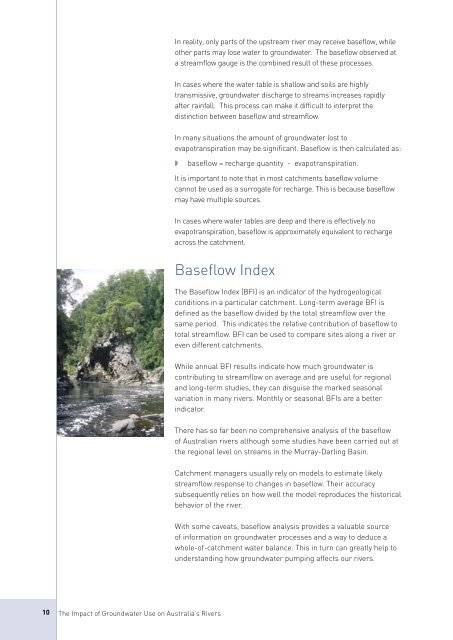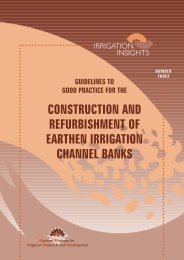The Impact of Groundwater Use of Australias Rivers
The Impact of Groundwater Use of Australias Rivers
The Impact of Groundwater Use of Australias Rivers
Create successful ePaper yourself
Turn your PDF publications into a flip-book with our unique Google optimized e-Paper software.
In reality, only parts <strong>of</strong> the upstream river may receive baseflow, while<br />
other parts may lose water to groundwater. <strong>The</strong> baseflow observed at<br />
a streamflow gauge is the combined result <strong>of</strong> these processes.<br />
In cases where the water table is shallow and soils are highly<br />
transmissive, groundwater discharge to streams increases rapidly<br />
after rainfall. This process can make it difficult to interpret the<br />
distinction between baseflow and streamflow.<br />
In many situations the amount <strong>of</strong> groundwater lost to<br />
evapotranspiration may be significant. Baseflow is then calculated as:<br />
◗<br />
baseflow = recharge quantity - evapotranspiration.<br />
It is important to note that in most catchments baseflow volume<br />
cannot be used as a surrogate for recharge. This is because baseflow<br />
may have multiple sources.<br />
In cases where water tables are deep and there is effectively no<br />
evapotranspiration, baseflow is approximately equivalent to recharge<br />
across the catchment.<br />
Baseflow Index<br />
<strong>The</strong> Baseflow Index (BFI) is an indicator <strong>of</strong> the hydrogeological<br />
conditions in a particular catchment. Long-term average BFI is<br />
defined as the baseflow divided by the total streamflow over the<br />
same period. This indicates the relative contribution <strong>of</strong> baseflow to<br />
total streamflow. BFI can be used to compare sites along a river or<br />
even different catchments.<br />
While annual BFI results indicate how much groundwater is<br />
contributing to streamflow on average and are useful for regional<br />
and long-term studies, they can disguise the marked seasonal<br />
variation in many rivers. Monthly or seasonal BFIs are a better<br />
indicator.<br />
<strong>The</strong>re has so far been no comprehensive analysis <strong>of</strong> the baseflow<br />
<strong>of</strong> Australian rivers although some studies have been carried out at<br />
the regional level on streams in the Murray-Darling Basin.<br />
Catchment managers usually rely on models to estimate likely<br />
streamflow response to changes in baseflow. <strong>The</strong>ir accuracy<br />
subsequently relies on how well the model reproduces the historical<br />
behavior <strong>of</strong> the river.<br />
With some caveats, baseflow analysis provides a valuable source<br />
<strong>of</strong> information on groundwater processes and a way to deduce a<br />
whole-<strong>of</strong>-catchment water balance. This in turn can greatly help to<br />
understanding how groundwater pumping affects our rivers.<br />
10<br />
<strong>The</strong> <strong>Impact</strong> <strong>of</strong> <strong>Groundwater</strong> <strong>Use</strong> on Australia’s <strong>Rivers</strong>

















